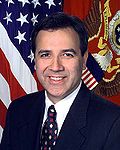This is a list of University of New Mexico presidents includes all permanent and interim presidents from the beginning of instruction in 1892 to the present. [1] [2]
| No. | Image | President | Term start | Term end | Refs. |
|---|---|---|---|---|---|
| 1 | Elias S. Stover | 1891 | 1897 | ||
| 2 |  | Clarence L. Herrick | 1897 | 1901 | |
| 3 | William G. Tight | 1902 | 1909 | ||
| 4 | Edward D. M. Gray | 1909 | 1912 | ||
| 5 |  | David R. Boyd | 1912 | 1919 | |
| 6 | David S. Hill | 1919 | 1927 | ||
| 7 | James Fulton Zimmerman | 1927 | 1944 | ||
| 8 | John Philip Wernette | 1945 | 1948 | ||
| 9 | Thomas L. Popejoy | 1948 | 1968 | ||
| 10 | Ferrel Heady | 1968 | 1975 | ||
| 11 | William E. "Bud" Davis | 1975 | 1982 | ||
| 12 | John Perovich | 1982 | 1984 | ||
| 13 | Tom Farer | 1985 | 1986 | ||
| 14 | Gerald May | 1986 | 1990 | ||
| 15 | Richard Peck | 1990 | 1998 | ||
| 16 | William C. Gordon | 1999 | 2002 | ||
| 17 |  | F. Chris Garcia | 2002 | 2003 | |
| 18 |  | Louis Caldera | August 1, 2003 | January 25, 2006 | [3] [4] |
| 19 | David W. Harris | January 25, 2006 | May 31, 2007 | [5] | |
| 20 | David J. Schmidly | June 1, 2007 | May 31, 2012 | [6] [7] | |
| 21 |  | Robert G. Frank | June 1, 2012 | December 31, 2016 | [8] [9] |
| 22 | Chaouki T. Abdallah | January 1, 2017 | February 28, 2018 | [10] | |
| 23 | Garnett S. Stokes | March 1, 2018 | present | [11] |